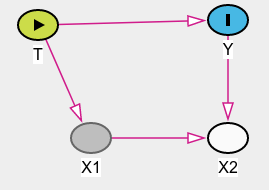I have made the following model in DAGitty:
Where $X_2$ is controlled for.
DAGitty says:
The total effect cannot be estimated due to adjustment for an intermediate or a descendant of an intermediate.
I asked here whether it would be possible to obtain the treatment effect after controlling for $x_2$.
But I guess my fundamental question is: if I control for both $x_2$ and $x_1$, why, from the theory of DAGs, that doesn't identify the treatment effect?
I mean, controlling for $x_2$, which is a collider, open a backdoor path $x_1 \leftrightarrow y$. But controlling for $x_1$ should close this backdoor path again.
Why, from a theoretical perspective, that doesn't happen?
I will reinforce my understanding of how that should work with another example.
Consider the following DAG:
where $x$ is the treatment, and $y$ is the outcome.
In this DAG I can control for nothing.
Or I can control for $\{m,a\}$, or for $\{m,b\}$, or for $\{m,a,b\}$.
In fact, m$m$ is a collider, and controlling for it induces a backdoor path $x \leftrightarrow a \leftrightarrow m \leftrightarrow b \leftrightarrow y$$x \leftrightarrow a \leftrightarrow b \leftrightarrow y$.
But I can close the backdoor path so opened by controlling for also $a$, or for also $b$, or for also $a$ and $b$ together.
Why that doesn't happen with the first DAG I posted?
If I control for $x_2$ (the collider), and so open the backdoor path $t \leftrightarrow x1 \leftrightarrow x2 \leftrightarrow y$$t \leftrightarrow x1 \leftrightarrow y$, why I can't close the backdoor path so opened by controlling for $x_1$?
I would like an answer from a theoretical point of view.


